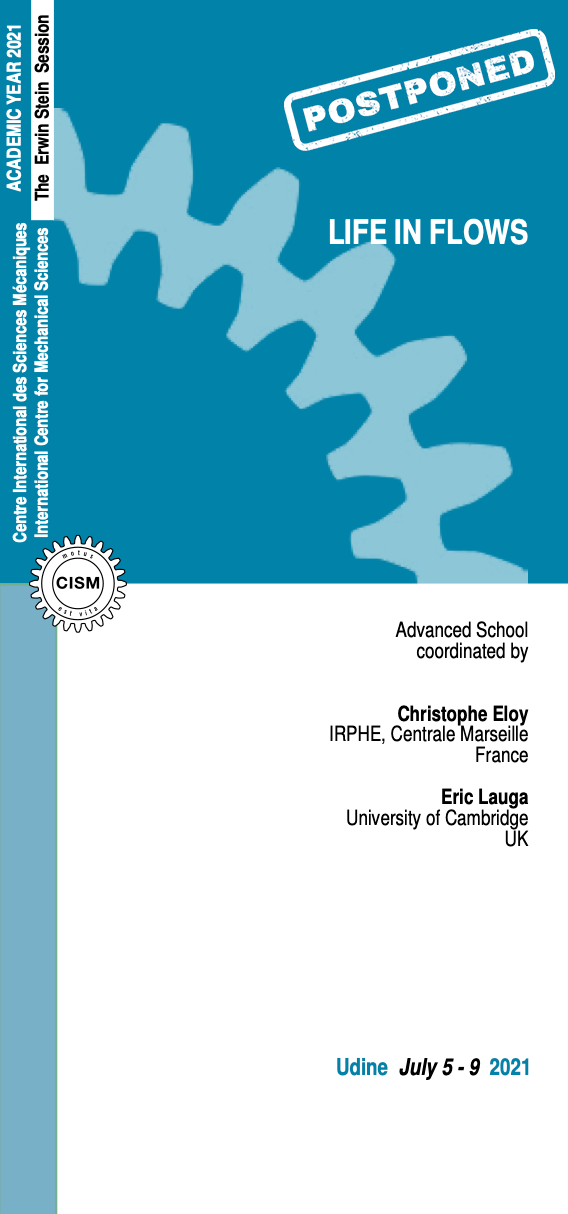Whether in ocean or in air, biological organisms interact with a surrounding fluid, these interactions being often critical for their survival. How do these organisms sense surrounding flows? How do they react to this sensing information? And what are the forces applied from the flows to the organisms? Today, many of these fluid-structure interaction problems are not fully understood and a lot of research effort is devoted to unravel the complex mechanisms at play.
At the smallest scale are bacteria. Although they are the world’s smallest cells, they represent the bulk of the world’s biomass. Most bacteria are motile and swim with flagella, which consist of slender helical appendages rotated by specialized motors. We will provide an overview of the motility system for bacteria, of the coupling between internal chemical osmotic state and sensory transduction at the molecular level, and the behaviour of cells in flows.
At a larger scale, we will look at plankton. The three main missions of any organism (growing, reproducing, and surviving) depend on encounters with food and mates, and on avoiding encounters with predators. Through natural selection, the behaviour and ecology of plankton organisms have evolved to optimize these tasks. We will offer a mechanistic approach to the study of ocean ecology by exploring biological interactions in plankton at the individual level.
We will then address insect flight. Starting from the Navier-Stokes equations governing the unsteady aerodynamics of flapping flight, we will build a theoretical framework to understand flight mechanics. This will lead to new interpretations and predictions of the functions of an insect’s internal machinery that orchestrate its flight.
We will also address the mechanics, energetics and control of fish swimming. Fish routinely encounter unsteady flows in nature, such as when schooling or swimming behind a rock in a stream. We will show how fish can sense the flow through their lateral line and how they can extract energy from their environment.
At the largest scale, we will examine collective animal motion, a ubiquitous behaviour that can be found in insect swarms, starling murmurations, fish schools or even crowd phenomena. We will explain how large-scale order can emerge from local interactions, without any leader. We will also discuss the importance of the fluid interactions and how a group can react to a predatory attack.
Finally, we will examine the algorithms used by organisms to search the source of an odour in a flow. These algorithms can be very dependent on the size of the organism and on the sensing information at its disposal. On small scales, bacteria use biased random walk to swim up the gradients of concentration, but on larger scales, gradients are not a relevant information anymore. Moths and large crustaceans generally use different algorithms combining “zigzagging” and “casting” behaviours.
Since the objective of this school is to introduce the topic of “Life in Flows”, particular attention will be paid to biological concepts. We will also allocate time for attendees to present their own research via short talks. The targeted audience for this school will be PhD students, postdoctoral, and young researchers in departments of Physics, Biophysics, Applied Mathematics and Engineering.
Berg H. C. (2003) The rotary motor of bacterial flagella, Annual Review Biochemestry 72:19-54.
Berg H.C. (2004) E. coli in Motion (Springer, New York).
Kiørboe, T. (2008) A Mechanistic Approach to Plankton Ecology. Princeton: Princeton University Press, 209 pp.
Hemelrijk, C. K., & Hildenbrandt, H. (2015). Diffusion and topological neighbours in flocks of starlings: Relating a model to empirical data. PLoS ONE, 10(5).
Hemelrijk, C. K., van Zuidam, L., & Hildenbrandt, H. (2015). What underlies waves of agitation in starling flocks. Behavioral Ecology and Sociobiology, 69(5).
Inada, Y., & Kawachi, K. (2002). Order and flexibility in the motion of fish schools. Journal of Theoretical Biology, 214(3), 371–387.
Liao, J. C., Beal, D. N., Lauder, G.V., and Triantafyllou, M.S. (2003) Fish exploiting vortices use less muscle. Science 302, 1566-1569.
Liao, J. C. (2007). A review of fish swimming mechanics and behaviour in altered flows. Philosophical Transactions of the Royal Society B: Biological Sciences, 362(1487), 1973-1993.
Purcell E.M. (1977) Life at low Reynolds number, American Journal of Physics, 45:3-11.
Vergassola, M., Villermaux, E., & Shraiman, B. I. (2007). ‘Infotaxis’ as a strategy for searching without gradients. Nature, 445(7126), 406.
Wang, Z. J. (2005). Dissecting insect flight. Annual Review Fluid Mechanics, 37, 183-210.
Wang, Z. J. (2016). Insect flight: From newton's law to neurons. Annual Review of Condensed Matter Physics, 7, 281-300.
6 lectures on: Life at low Reynolds number. Viscous drag. Diffusion and viscous media. Swimming of common bacteria (cells with external flagellar filaments). Swimming of spirochetes (cells with internal flagellar filaments). Gliding motility (cells with adhesins, racks and pinions). Flagellar filaments. Structure. Polymorphic transformations. Flagellar motors. Chemotaxis. The sensory transduction pathway: coupling of receptors to motors. Adaptation by receptor methylation. Adaptation by motor remodeling.
4 lectures on: Search algorithms used by organisms to track the source of an odour in a flow. Biased random walk; Lévy flight; Chemical trail-following; Zigzagging and casting behaviours; Infotaxis.
6 lectures on: Collective motion in groups of fish and birds (regarding turning behaviour and internal structure of a flock); collective escape of attacks by predators, studied both empirically and in computational models regarding effects of type of locomotion, type of attack and type of transmission of individual responses in the flock.
6 lectures on: Plankton encounter rates, the fluid dynamics of marine snow formation by physical coagulation, how microbial predators and prey perceive their environment through fluid signals and chemical cues, and how fluid physics constrain and facilitate microbial predator-prey encounter rates.
6 lectures on: Fish diversity, anatomy and morphology, physical principles of aquatic locomotion, experimental approaches to studying fish locomotion, powered and passive locomotion, swimming in turbulence, Kármán gaiting, schooling, flow sensing with the lateral line system.
6 lectures on: Falling Paper and Unsteady Aerodynamics. Aerodynamics of insect flapping flight; computational tools for studying flight dynamics; kinematics and dynamics in free flight; algorithms for tacking freely flying insects; neural feedback control algorithms used by insects.





